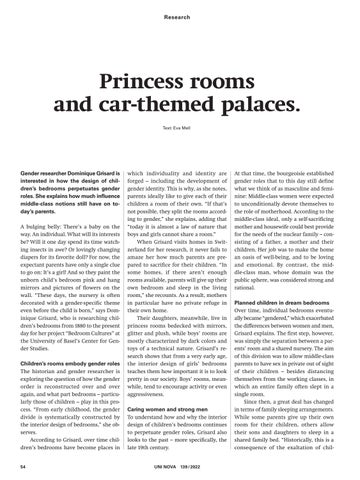Research
Princess rooms and car-themed palaces. Text: Eva Mell
Gender researcher Dominique Grisard is interested in how the design of children’s bedrooms perpetuates gender roles. She explains how much influence middle-class notions still have on today’s parents. A bulging belly: There’s a baby on the way. An individual. What will its interests be? Will it one day spend its time watching insects in awe? Or lovingly changing diapers for its favorite doll? For now, the expectant parents have only a single clue to go on: It’s a girl! And so they paint the unborn child’s bedroom pink and hang mirrors and pictures of flowers on the wall. “These days, the nursery is often decorated with a gender-specific theme even before the child is born,” says Dominique Grisard, who is researching children’s bedrooms from 1880 to the present day for her project “Bedroom Cultures” at the University of Basel’s Center for Gender Studies. Children’s rooms embody gender roles The historian and gender researcher is exploring the question of how the gender order is reconstructed over and over again, and what part bedrooms – particularly those of children – play in this process. “From early childhood, the gender divide is systematically constructed by the interior design of bedrooms,” she observes. According to Grisard, over time children’s bedrooms have become places in
54
which individuality and identity are forged – including the development of gender identity. This is why, as she notes, parents ideally like to give each of their children a room of their own. “If that’s not possible, they split the rooms according to gender,” she explains, adding that “today it is almost a law of nature that boys and girls cannot share a room.” When Grisard visits homes in Switzerland for her research, it never fails to amaze her how much parents are prepared to sacrifice for their children. “In some homes, if there aren’t enough rooms available, parents will give up their own bedroom and sleep in the living room,” she recounts. As a result, mothers in particular have no private refuge in their own home. Their daughters, meanwhile, live in princess rooms bedecked with mirrors, glitter and plush, while boys’ rooms are mostly characterized by dark colors and toys of a technical nature. Grisard’s research shows that from a very early age, the interior design of girls’ bedrooms teaches them how important it is to look pretty in our society. Boys’ rooms, meanwhile, tend to encourage activity or even aggressiveness. Caring women and strong men To understand how and why the interior design of children’s bedrooms continues to perpetuate gender roles, Grisard also looks to the past – more specifically, the late 19th century.
UNI NOVA
139 / 2022
At that time, the bourgeoisie established gender roles that to this day still define what we think of as masculine and feminine: Middle-class women were expected to unconditionally devote themselves to the role of motherhood. According to the middle-class ideal, only a self-sacrificing mother and housewife could best provide for the needs of the nuclear family – consisting of a father, a mother and their children. Her job was to make the home an oasis of well-being, and to be loving and emotional. By contrast, the middle-class man, whose domain was the public sphere, was considered strong and rational. Planned children in dream bedrooms Over time, individual bedrooms eventually became “gendered,” which exacerbated the differences between women and men, Grisard explains. The first step, however, was simply the separation between a parents’ room and a shared nursery. The aim of this division was to allow middle-class parents to have sex in private out of sight of their children – besides distancing themselves from the working classes, in which an entire family often slept in a single room. Since then, a great deal has changed in terms of family sleeping arrangements. While some parents give up their own room for their children, others allow their sons and daughters to sleep in a shared family bed. “Historically, this is a consequence of the exaltation of chil-
















